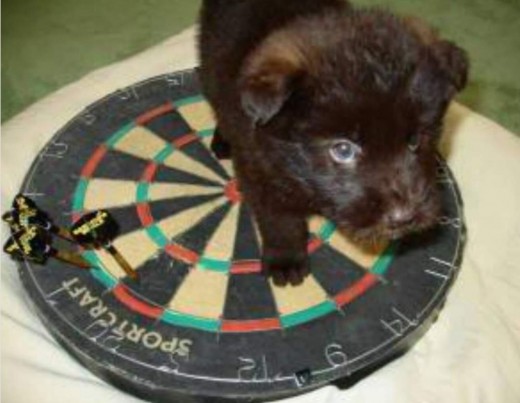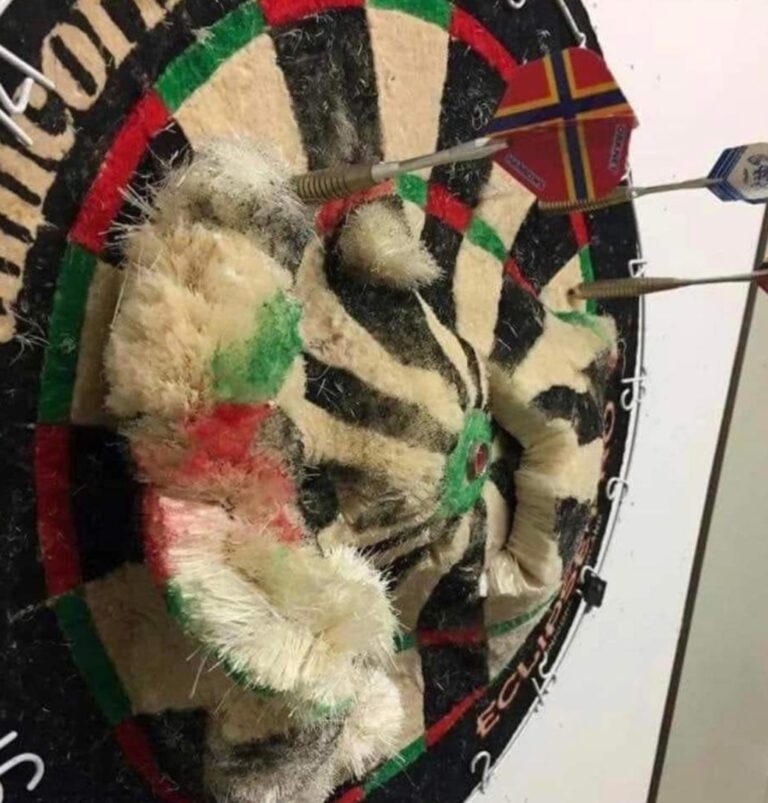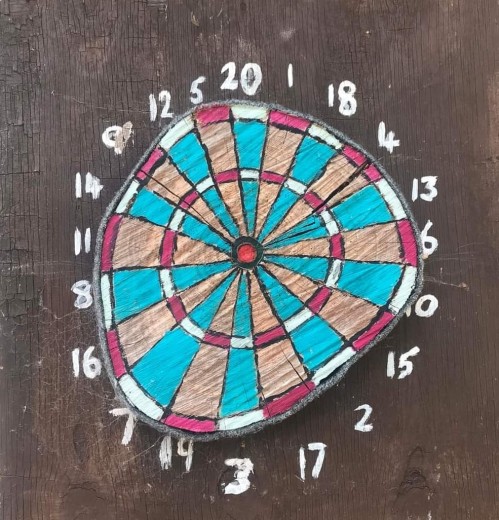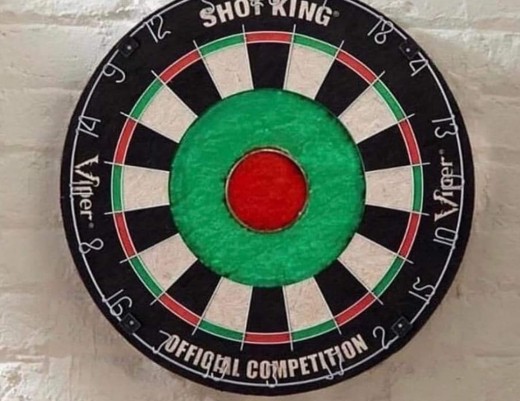Friday, July 1, 2016
Column 517
Darts on Easter Island?
Getting to one of the most isolated islands on Earth, Easter Island, is a journey even in the most normal of circumstances. Getting there from another of the most remote places on earth, Machu Picchu, is exponentially more challenging. But traveling from Machu Picchu to Easter Island with the owner of Horizon Darts, Terry Manses, was a wild ride!
When we last left this space, Terry had just miraculously recovered her purse – which for reasons unexplained she carried into the sprawling Machu Picchu ruins. Along with Stacy Bromberg we were beginning to wend our way back to civilization.
As we prepared to board our flight from Lima to Santiago, Terry struck again.
One would think the owner of a darts company and veteran world traveler would know that attempting to carry a set of steel-tip darts past security and onto an airplane was certain to be problematic. Still, Terry tried. She was stopped at the magnetometers, manhandled, handcuffed and led away like a common criminal.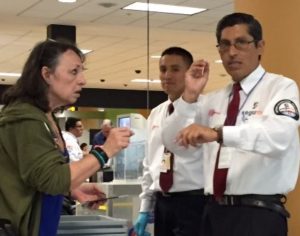
Okay, that’s a lie. But the truth is crazier. What Terry did was make the most persuasive case I have ever witnessed to be allowed to carry her darts onto the flight. Of course, she struck out, not that it was of any consequence – back at her Kansas City company she has thousands of sets. In the process though she taught an intrigued security guard how to grip and toss a dart.
After waiting hours for our hotel rooms and while Stacy fought with the hotel staff, Terry and I headed into the Santiguan afternoon to find Fiddler’s Irish Bar (Dr. Manuel Barros Borgoño 13) – recommended as the place to get a game in Chile’s capital city. Distracted by curio shops, we didn’t make it to the joint but it mattered not since Terry’s darts were in Peru.
About breakfast time the next morning it was wheels up for the 5.5-hour LAN Airlines flight to Easter Island, unfathomably isolated almost 2,200 miles off the Chilean coast in the southeastern Pacific Ocean. With but one “minor” exception, seated directly across the aisle from me, the flight was uneventful. One of the great mysteries of the universe is why this kid, always screaming and pooping, insists on following me everywhere I fly.
 Excitedly, we spotted land at about the five-hour mark. The plane may have listed slightly as the passengers leaned to snap photographs from the right-side windows. We touched down and taxied along a lengthy runway built by NASA as an alternate landing point for the Space Shuttle.
Excitedly, we spotted land at about the five-hour mark. The plane may have listed slightly as the passengers leaned to snap photographs from the right-side windows. We touched down and taxied along a lengthy runway built by NASA as an alternate landing point for the Space Shuttle.
One can only imagine how the Polynesians who navigated in canoes or catamarans and discovered this island (sometime between 700 and 1100 CE – approximately coinciding with the arrival of the first settlers in Hawaii) or the Dutch explorer, Jacob Roggeveen, who landed here on Easter Sunday in 1722 (hence the island’s name) felt when, finally, they first sighted the shores of this far-flung 15- by 7-mile plot of raw and volcanic tropical land.
We headed to our hotel (Tahatani, a virtual paradise just a couple blocks off the main drag) in Hanga Roa, the only village on the island, where near 100% of the 5,800 current residents live (60% of them descendents of the aboriginal Rapa Nui). We walked into town to explore the shops and went in search of the island’s only darts bar, the Galway Irish Bar (Lasserre 108), which unfortunately no longer exists. We shouldn’t have been surprised. Hanga Roa is the only place on the island where there is electricity and running water. There is a bank, hospital, post office, fire station, pharmacy and about a thousand souvenir shops.
Somewhere along the way Terry lost her wallet and credit cards. She retraced her steps and found them, in her purse which she had with her the entire time. I worry about Terry.
Literally 100% of the people who travel here, about 150,000 annually, come for one single purpose – to see the mysterious giant heads (moai – pronounced mow-eye). The economy is 100% tourism-based. In town, I bought an “authentic” miniature marble head imported from China.
We returned to Tahatani for a drink and met a dog named Jenny. We thought she was a stray – strays, all friendly, are everywhere – but Jenny had a family close by, was extra friendly and a fan of pretzels.  Along a path lined in colorful flowers we passed a somewhat disconcerting sign pointing to a tsunami evacuation route – one can only imagine where the path leads. We learned that cyclones or hurricanes have never touched the island but that years ago a tsunami slammed ashore and washed many of the multi-ton statues a couple of football fields inland.
Along a path lined in colorful flowers we passed a somewhat disconcerting sign pointing to a tsunami evacuation route – one can only imagine where the path leads. We learned that cyclones or hurricanes have never touched the island but that years ago a tsunami slammed ashore and washed many of the multi-ton statues a couple of football fields inland.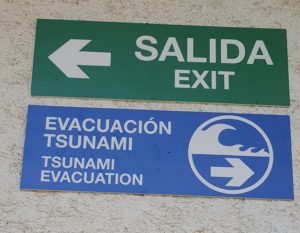
The island is virtually crime free. Other than tsunamis the only danger is being conked from above by a coconut falling from a tree. I suppose there is one more danger – the massive fine that will be levied if one tries to leave the island with a chunk of one of the moai. Recently a German tourist lopped an ear off one on the heads and was fined $100,000.
Eventually, we ended up at a spectacular seaside restaurant where we did everything we would have done (drink) had we located the darts. Pisco sour, made from fermented grapes, is the unofficial island beverage. We sampled a few and amidst thousands of flitting dragonflies we watched the sun set in a mesmerizing giant ball of red-orange flame on the Pacific horizon.
At daybreak, with (of course) dartboard in tow, we headed to the heads in Rapa Nui National Park (which encompasses 90% of the island)…
I don’t know about Terry and Stacy, but I have dreamed of traveling to Easter Island ever since I read Thor Heyerdah’s Kon-Tiki as a teenager, in 1995. When across a grassy field we caught our first glimpse of the pock-marked carvings I was transported to my youth and into the pages of Heyerdahl’s 1947 journey in a balsa raft 4,200 nautical miles across the Pacific to this very same spot.
In various stages of repair or disrepair there are some 900 moai scattered about the island, averaging perhaps 30 feet in height and 80 tons in weight. The tallest, or longest, is 70 feet in length, and still captive in the solidified volcanic rock quarry (Rano Raraku) where most of the statues were carved. It is believed it took a half-dozen men using stone hand chisels – mainly basalt – a year or more to carve each statue. Most have names and represent the likenesses of a deified ancestor. When a chief or important person died a head was commissioned. There is one kind of odd-looking statue, entirely bald, called Howie Reed.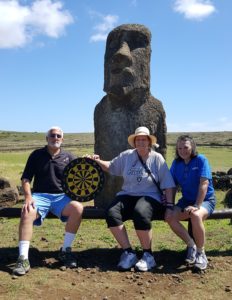
The heads (actually many are full bodied but only the heads and shoulders are visible, their torsos buried by centuries of storms and shifting soil) were carved from the volcanic rock quarry while laying prone. Carefully, they were levered upright, rocked back and forth and pulled with ropes or slid along rows of tree trunks to their final location. 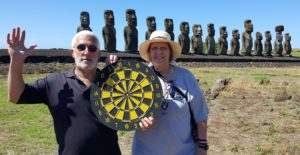 Many were positioned on ahu (raised stone platforms on the coastline, miles from the quarry) to watch over their descendents in the settlements with their backs toward the spirit world in the sea. Today, all of the moai have eerie empty eye sockets. Long ago, the moai were all toppled by rival tribes and their white coral eyes were gouged out. Only one eye remains – in a museum.
Many were positioned on ahu (raised stone platforms on the coastline, miles from the quarry) to watch over their descendents in the settlements with their backs toward the spirit world in the sea. Today, all of the moai have eerie empty eye sockets. Long ago, the moai were all toppled by rival tribes and their white coral eyes were gouged out. Only one eye remains – in a museum.
While there is more to do on Easter Island than wander among the moai (caves to explore, petroglyphs – more then 4,000, one of the richest collections in all Polynesia – ancient stone walls and foundations of centuries-old houses, exotic beaches, even stone chicken coops) the adventure is mostly about the moai.
The perplexing age-old question is: What happened to the once thriving 15,000 strong Rapa Nui civilization in the 1600s to reduce it to just 111 in the late 1800s?
Most people think (school children have been taught) that the Rapa Nui cut down all their trees (once the island was almost entirely covered in palms) and overused their resources to build the heads – to the extent they wiped themselves out. This is not so. They cut tress to clear land to grow crops but this is not what doomed the civilization.
While numerous factors – slave raiders, tuberculosis introduced by whalers, internal warfare – contributed to the decline, the prevailing thinking today is that the primary culprit was… rats.
Yes, rats.
(NOTE: In the interest of journalistic integrity it must be stated that Stacy vehemently disagrees – she is convinced everything is Barak Obama’s fault.)
But nope, it was rats.
Possibly arriving as stowaways but more likely introduced on purpose as a protein source, rats had an insatiable taste for palm nuts. As the human population increased and the need for food increased the rat population also grew, but exponentially – to millions. They gnawed away at the palm nuts and new trees couldn’t germinate. They decimated multiple plant species and crops. This is not to discount the impact of overharvesting, overhunting, overpopulation, deforestation, climate change, wars, disease, and slavery – but the educated theory today is that the key catalyst in the decline was the little old Polynesian rat and not some silly idea that the Rapa Nui chopped down all their trees to move giant heads.
On the final day of our journey we returned to our restaurant by the sea. We were told by a couple we met that the owner would be amenable to our installing our dartboard…
But, you know, we didn’t even take it along. There are times, albeit rare, when darts just isn’t that important. This was one of them. Plus, Stacy and I had our hands full with a much more critical matter. We had to keep a careful eye Terry to make sure she didn’t lose her purse, yet again.
After all, Terry does own Horizon Darts. Her job was to pay for dinner.
From the Field,
Dartoid

